
本期带大家一起用C语言实现队列🌈🌈🌈
文章目录
- 1、队列的概念
- 2、队列的操作流程
- 3 、队列的结构
- 4、队列的实现
- 4.1 队列的结构设计
- 4.2 队列的初始化
- 4.3 入队
- 4.4 判断队列是否为空
- 4.5 出队
- 4.6 获取队头数据
- 4.7 获取队尾数据
- 4.8 获取队列当中数据的个数
- 4.9 队列的销毁
- 5、栈和队列OJ题
- 5.1 [队列模拟栈](https://leetcode.cn/problems/implement-stack-using-queues/)
- 5.2 栈模拟队列
- 5.3 循环队列
- 6、感谢与交流✅
1、队列的概念
队列是一种线性数据结构,它按照先进先出(FIFO)的原则进行操作。可以把队列想象成排队买票或者排队上公交车的队伍。
顺序队列由一个连续的内存区域组成,可以存储多个元素。队列有两个指针,分别指向队头(Front)和队尾(Rear)。
链式队列由一系列节点构成,每个节点包含存储的元素值和指向下一个节点的指针
队列的基本操作包括:
- 入队(Enqueue):将新元素插入到队尾,如果队列已满则无法插入。
- 出队(Dequeue):移除队头元素,并返回该元素,如果队列为空则无法执行。
- 获取队头元素(Front):获取队头元素的值,但不对队列进行修改。
- 判断队列是否为空(isEmpty):判断队列中是否没有任何元素。
- 判断队列是否已满(isFull):判断队列是否已经达到了最大容量。
队列的操作遵循先进先出的原则,即先入队的元素先出队。在队列中,新元素被插入到队列的末尾,而出队操作始终从队列的头部进行。
队列常用于需要顺序处理任务或数据的场景,例如处理请求、消息传递、广度优先搜索等算法实现。此外,队列还可以通过循环队列的方式来实现,使得已经出队的元素可以再次被插入到队列的末尾,有效地利用内存空间。
2、队列的操作流程

3 、队列的结构
队列通常使用数组或链表来实现。以下是两种常见的队列结构:
-
基于数组的队列(
顺序队列):- 使用一个固定大小的数组来保存队列元素。
- 需要维护队头和队尾的索引,分别指向队列的第一个元素和最后一个元素。
- 入队操作将元素添加到队尾,并更新队尾索引。
- 出队操作将队头元素移除,并更新队头索引。
- 注意,入队操作可能导致队列满(队尾索引达到数组末尾)的情况,需要进行特殊处理。
-
基于链表的队列(
链式队列):- 使用链表来动态存储队列元素。
- 需要维护队头和队尾节点指针,分别指向队列的第一个节点和最后一个节点。
- 入队操作创建一个新节点,并将其链接到链表末尾,更新队尾指针。
- 出队操作移除队头节点,并更新队头指针。
- 注意,链式队列没有固定的大小限制,可以根据需要动态调整。
无论是基于数组还是链表的队列,其核心思想都是维护队头和队尾指针,并通过头部和尾部的插入和删除操作实现先进先出的特性。根据具体的应用场景和需求,选择适合的队列实现方式
在这里我们使用链表来实现队列,避免了用数组队列更新队头数据的遍历,时间复杂度低
4、队列的实现
4.1 队列的结构设计
Queue结构体,它表示整个队列。该结构体包含两个指针成员head和tail,分别指向队列的头部节点和尾部节点
QNode的结构体,它表示队列中的节点。该结构体包含一个指向下一个节点的指针next,以及一个数据data
typedef int QDataTYpe;typedef struct QueueNode
{struct QueueNode* next;QDataTYpe data;
}QNode;typedef struct Queue
{QNode* head;QNode* tail;int size;
}Queue;4.2 队列的初始化
现在主函数当中创建了一个Queue q
然后传入q的地址,进行初始化
将队列的头部指针和尾部指针设为NULL,并将队列的大小初始化为0
void QueueInit(Queue* pq)
{pq->head = NULL;pq->tail = NULL;pq->size = 0;
}4.3 入队
在函数内部,首先进行断言assert(pq)来确保指针pq不为空。
然后,通过动态内存分配malloc来创建一个新的节点newnode,并将其类型转换为QNode*。
接下来,检查是否成功分配内存,如果分配失败,则输出错误信息并返回。
然后,将新节点的数据成员data赋值为传入的参数x,同时将新节点的下一个指针next设置为NULL,新节点表示当前节点是队列的尾部节点。
接着,根据队列是否为空,有两种情况处理:
- 如果队列为空,即头部指针
head为NULL,表示当前队列没有任何节点,此时将头部指针和尾部指针都指向新节点newnode。 - 如果队列不为空,即头部指针
head不为NULL,表示当前队列已存在节点,此时将队列尾部节点的下一个指针next指向新节点newnode,然后将尾部指针tail更新为新节点newnode - 最后,将队列的大小
size加1,表示新增了一个节点。

void QueuePush(Queue* pq,QDataTYpe x)
{assert(pq);QNode* newnode = (QNode*)malloc(sizeof(QNode));;if (newnode == NULL){perror("malloc:fail");return;}newnode->data = x;newnode->next = NULL;if (pq->head == NULL){pq->head = pq->tail = newnode;}else{pq->tail->next = newnode;pq->tail = newnode;}pq->size++;}
4.4 判断队列是否为空
判断队列是否为空的话,相对来说是比较简单的
有两种判断方法
根据队列的头指针是否为空判断
根据队列当中的数据个数size判断
bool QueueEmpty(Queue* pq)
{return pq->head == NULL;//return pq->size==0;
}
4.5 出队
出队列的话我们需要先判断当前队列是否为空
队列为空的话那我们就直接返回
队列不为空的话又分两种情况
1、队头指针==队尾指针
2、队头指针!=队尾指针
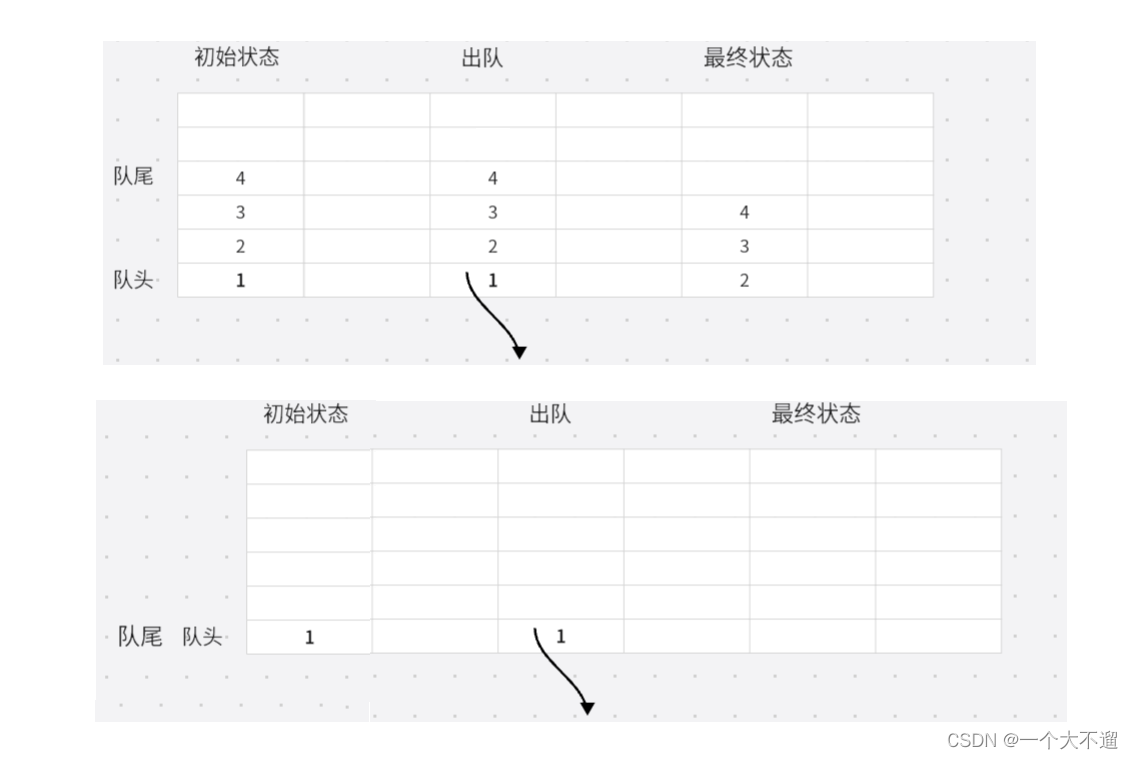
void QueuePop(Queue* pq)
{assert(pq);if (QueueEmpty(pq)){printf("队列为空\n");return;}if (pq->head == pq->tail){free(pq->head);pq->head = NULL;pq->tail = NULL;}else{QNode* next = pq->head->next;free(pq->head);pq->head = next;}pq->size--;
}
4.6 获取队头数据
获取队头数据的话,需要先判断队列是否为空,为空的话就直接返回
队列不为空,返回队头数据
QDataTYpe QueueFront(Queue* pq)
{assert(pq);if (QueueEmpty(pq)){printf("队列为空\n");return;}elsereturn pq->head->data;
}
4.7 获取队尾数据
获取队尾数据的话,同样需要判断队列是否为空,为空的话也就直接返回
队列不为空的话,返回队尾数据
QDataTYpe QueueBack(Queue* pq)
{assert(pq);if (QueueEmpty(pq)){printf("队列为空\n");return;}elsereturn pq->tail->data;
}4.8 获取队列当中数据的个数
获取队列数据的个数,直接返回pq->size
int QueueSize(Queue* pq)
{assert(pq);return pq->size;
}4.9 队列的销毁
使用循环遍历队列中的所有节点,直到遍历到最后一个节点,即当前节点为NULL
void QueueDestroy(Queue* pq)
{assert(pq);QNode* cur = pq->head;while (cur != NULL){QNode* next = cur->next;free(cur);cur = next;}pq->head = NULL;pq->tail = NULL;pq->size = 0;}
5、栈和队列OJ题
5.1 队列模拟栈
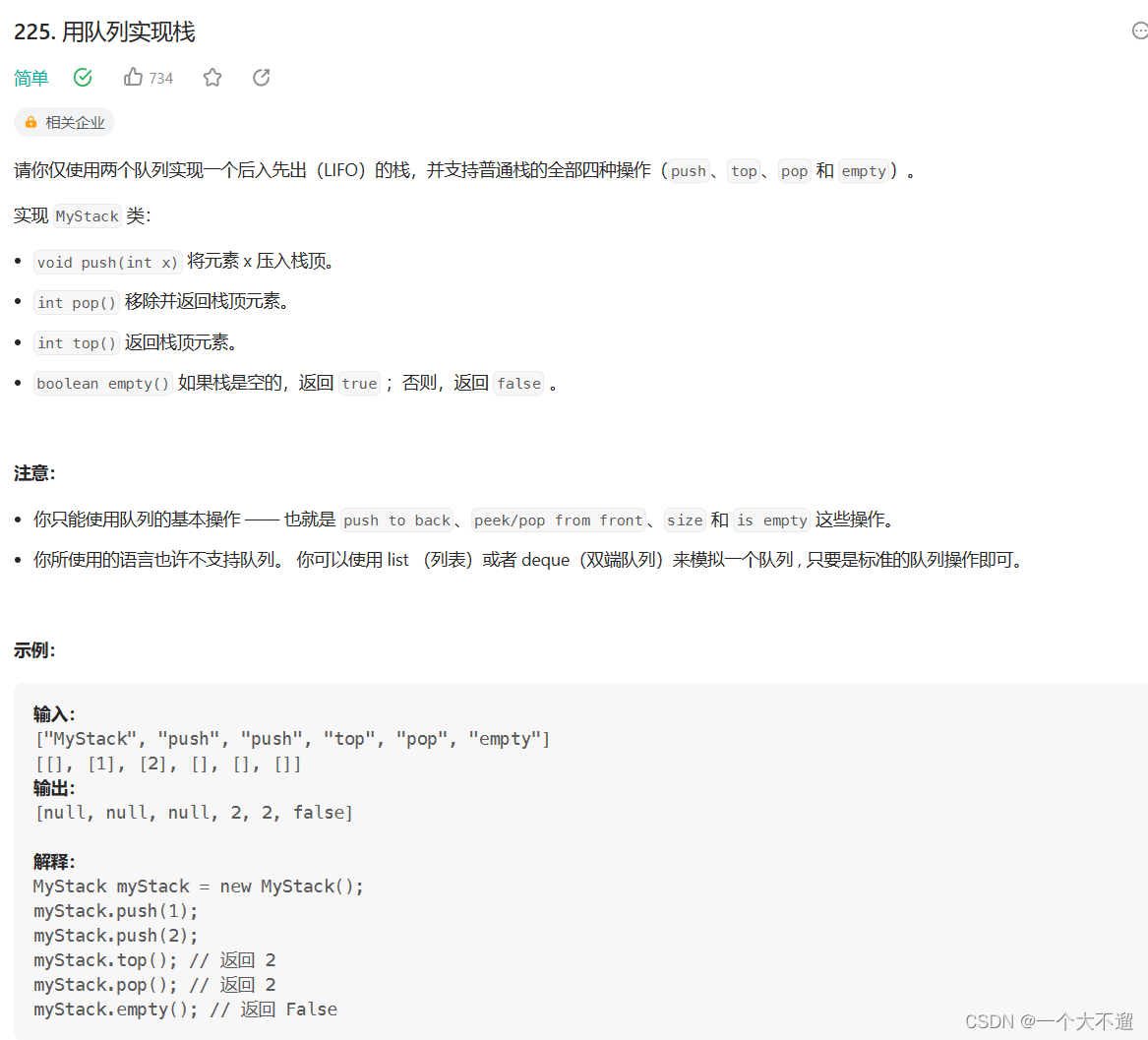
使用两个队列来实现栈的重点在于以下几点:
- 始终保持一个队列为空,另一个队列非空。
- 入数据时,将元素入队到不为空的队列中。
- 出数据时,将非空队列中的元素转移到空队列中,直到队列中只剩下一个元素。
- 出队原先非空队列的数据,原先非空队列变为空,即可实现栈的后进先出操作。
通过将元素入队到非空队列、转移到空队列以及出队的操作,可以模拟栈的后进先出特性

typedef int QDataTYpe;typedef struct QueueNode
{struct QueueNode* next;QDataTYpe data;
}QNode;typedef struct Queue
{QNode* head;QNode* tail;int size;
}Queue;void QueueInit(Queue* pq);void QueueDestroy(Queue* pq);void QueuePush(Queue* pq,QDataTYpe x);void QueuePop(Queue* pq);bool QueueEmpty(Queue* pq);QDataTYpe QueueFront(Queue* pq);QDataTYpe QueueBack(Queue* pq);int QueueSize(Queue* pq);
void QueueInit(Queue* pq)
{pq->head = NULL;pq->tail = NULL;pq->size = 0;
}void QueueDestroy(Queue* pq)
{assert(pq);QNode* cur = pq->head;while (cur != NULL){QNode* next = cur->next;free(cur);cur = next;}pq->head = NULL;pq->tail = NULL;pq->size = 0;}bool QueueEmpty(Queue* pq)
{return pq->head == NULL;//return pq->size==0;
}void QueuePush(Queue* pq,QDataTYpe x)
{assert(pq);QNode* newnode = (QNode*)malloc(sizeof(QNode));;if (newnode == NULL){perror("malloc:fail");return;}newnode->data = x;newnode->next = NULL;if (pq->head == NULL){pq->head = pq->tail = newnode;}else{pq->tail->next = newnode;pq->tail = newnode;}pq->size++;}void QueuePop(Queue* pq)
{assert(pq);if (QueueEmpty(pq)){printf("队列为空\n");return;}if (pq->head == pq->tail){free(pq->head);pq->head = NULL;pq->tail = NULL;}else{QNode* next = pq->head->next;free(pq->head);pq->head = NULL;pq->head = next;}pq->size--;
}QDataTYpe QueueFront(Queue* pq)
{assert(pq);assert(!QueueEmpty(pq));return pq->head->data;
}QDataTYpe QueueBack(Queue* pq)
{assert(pq);assert(!QueueEmpty(pq));return pq->tail->data;
}int QueueSize(Queue* pq)
{assert(pq);return pq->size;
}typedef struct {Queue q;Queue p;
} MyStack;MyStack* myStackCreate() {MyStack*obj=(MyStack*)malloc(sizeof(MyStack));if(obj==NULL){return NULL;}QueueInit(&obj->p);QueueInit(&obj->q);return obj;
}void myStackPush(MyStack* obj, int x) {if(QueueEmpty(&obj->p)){QueuePush(&obj->q,x);}else{QueuePush(&obj->p,x);}
}int myStackPop(MyStack* obj) {Queue*Empty=&obj->q;Queue*NoEmpty=&obj->p;if(QueueEmpty(&obj->p)){Empty=&obj->p;NoEmpty=&obj->q;}while(QueueSize(NoEmpty)>1){QueuePush(Empty,QueueFront(NoEmpty));QueuePop(NoEmpty);}int top=QueueFront(NoEmpty);QueuePop(NoEmpty);return top;
}int myStackTop(MyStack* obj) {if(QueueEmpty(&obj->p)){return QueueBack(&obj->q);}elsereturn QueueBack(&obj->p);
}bool myStackEmpty(MyStack* obj) {return QueueEmpty(&obj->q)&&QueueEmpty(&obj->p);
}void myStackFree(MyStack* obj) {QueueDestroy(&obj->q);QueueDestroy(&obj->p);free(obj);
}
5.2 栈模拟队列
栈模拟队列
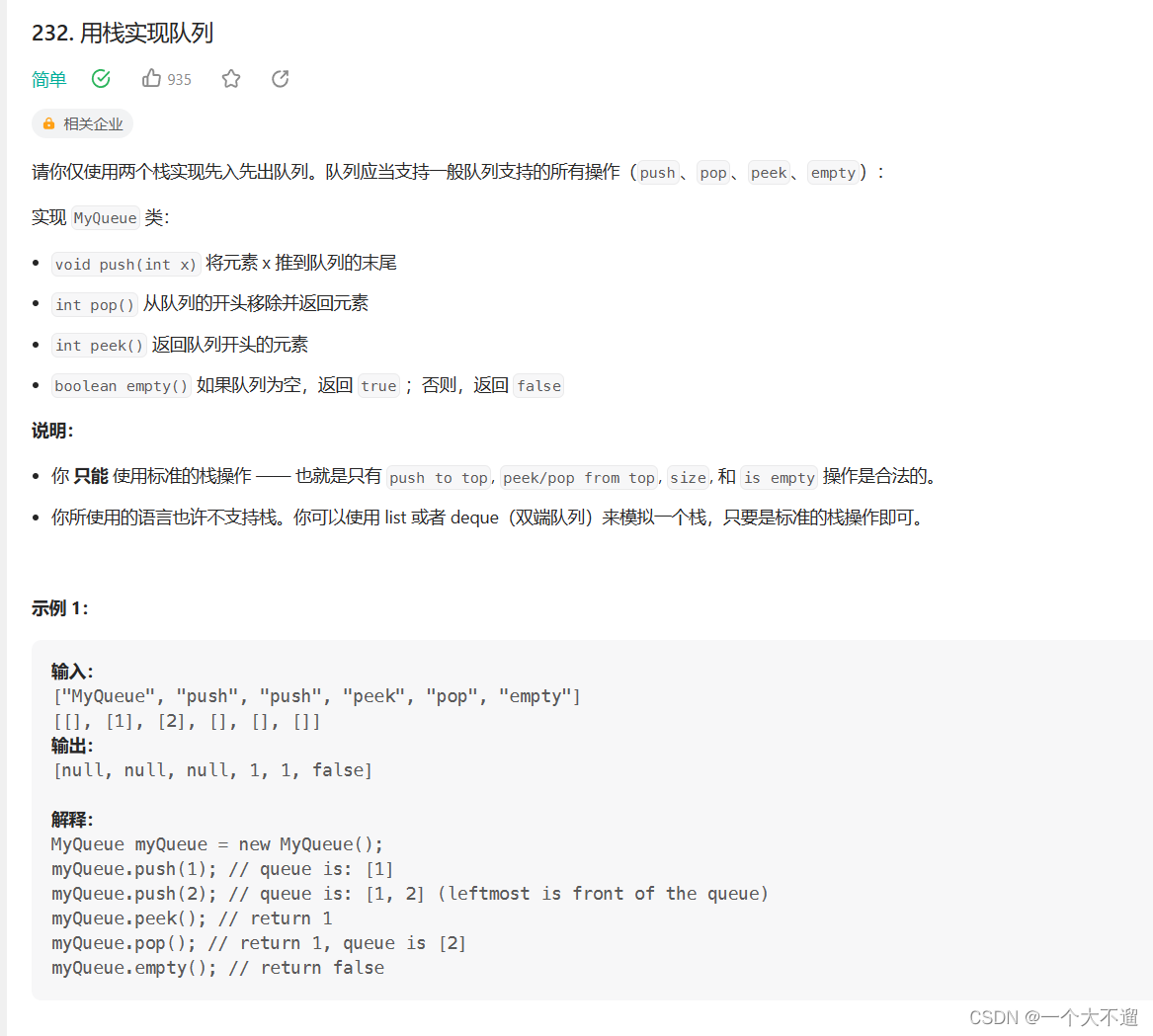
栈模拟队列的话,可以想象成一个连通器

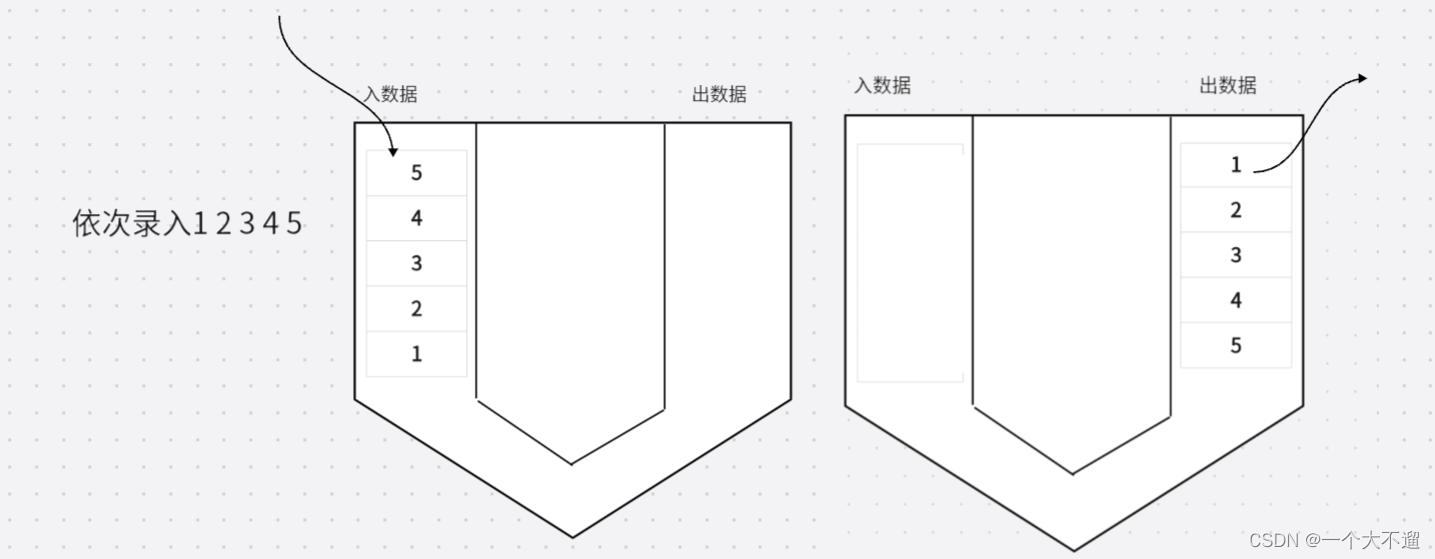
typedef int STDataType;typedef struct Stack
{STDataType* a;int top;int capacity;
}ST;//初始化
void STInit(ST* ps);//销毁
void STDestroy(ST* ps);//压栈void STPush(ST* ps,STDataType x);//出栈void STPop(ST* ps);//判空bool STEmpty(ST* ps);//栈顶STDataType STTop(ST* ps);//个数int STSize(ST* ps);void STInit(ST* ps)
{assert(ps);ps->a = NULL;ps->capacity = 0;ps->top = 0;}void STDestroy(ST* ps)
{assert(ps);free(ps->a);ps->a = NULL;ps->capacity = 0;ps->top = 0;
}void STPush(ST* ps,STDataType x)
{assert(ps);if (ps->top == ps->capacity){int newcapacity = ps->capacity == 0 ? 4 : ps->capacity * 2;STDataType* tmp = (STDataType*)realloc(ps->a, newcapacity*sizeof(STDataType));if (tmp == NULL){perror("realloc :fail");return;}ps->a = tmp;ps->capacity = newcapacity;}ps->a[ps->top++] = x;}bool STEmpty(ST* ps)
{return ps->top == 0;
}void STPop(ST* ps)
{assert(ps);assert(!STEmpty(ps));ps->top--;
}STDataType STTop(ST* ps)
{assert(ps);return ps->a[ps->top - 1];}int STSize(ST* ps)
{assert(ps);return ps->top;}typedef struct {ST pushst;ST popst;
} MyQueue;MyQueue* myQueueCreate() {MyQueue*obj=(MyQueue*)malloc(sizeof(MyQueue));STInit(&obj->pushst);STInit(&obj->popst);return obj;}void myQueuePush(MyQueue* obj, int x) {STPush(&obj->pushst,x);}int myQueuePop(MyQueue* obj) {int ret=myQueuePeek(obj);STPop(&obj->popst);return ret;}int myQueuePeek(MyQueue* obj) {if(STEmpty(&obj->popst)){while(!(STEmpty(&obj->pushst))){STPush(&obj->popst,STTop(&obj->pushst));STPop(&obj->pushst);}}return STTop(&obj->popst);
}bool myQueueEmpty(MyQueue* obj) {return STEmpty(&obj->pushst)&&STEmpty(&obj->popst);
}void myQueueFree(MyQueue* obj) {STDestroy(&obj->pushst);STDestroy(&obj->popst);free(obj);
}/*** Your MyQueue struct will be instantiated and called as such:* MyQueue* obj = myQueueCreate();* myQueuePush(obj, x);* int param_2 = myQueuePop(obj);* int param_3 = myQueuePeek(obj);* bool param_4 = myQueueEmpty(obj);* myQueueFree(obj);
*/
5.3 循环队列
循环队列
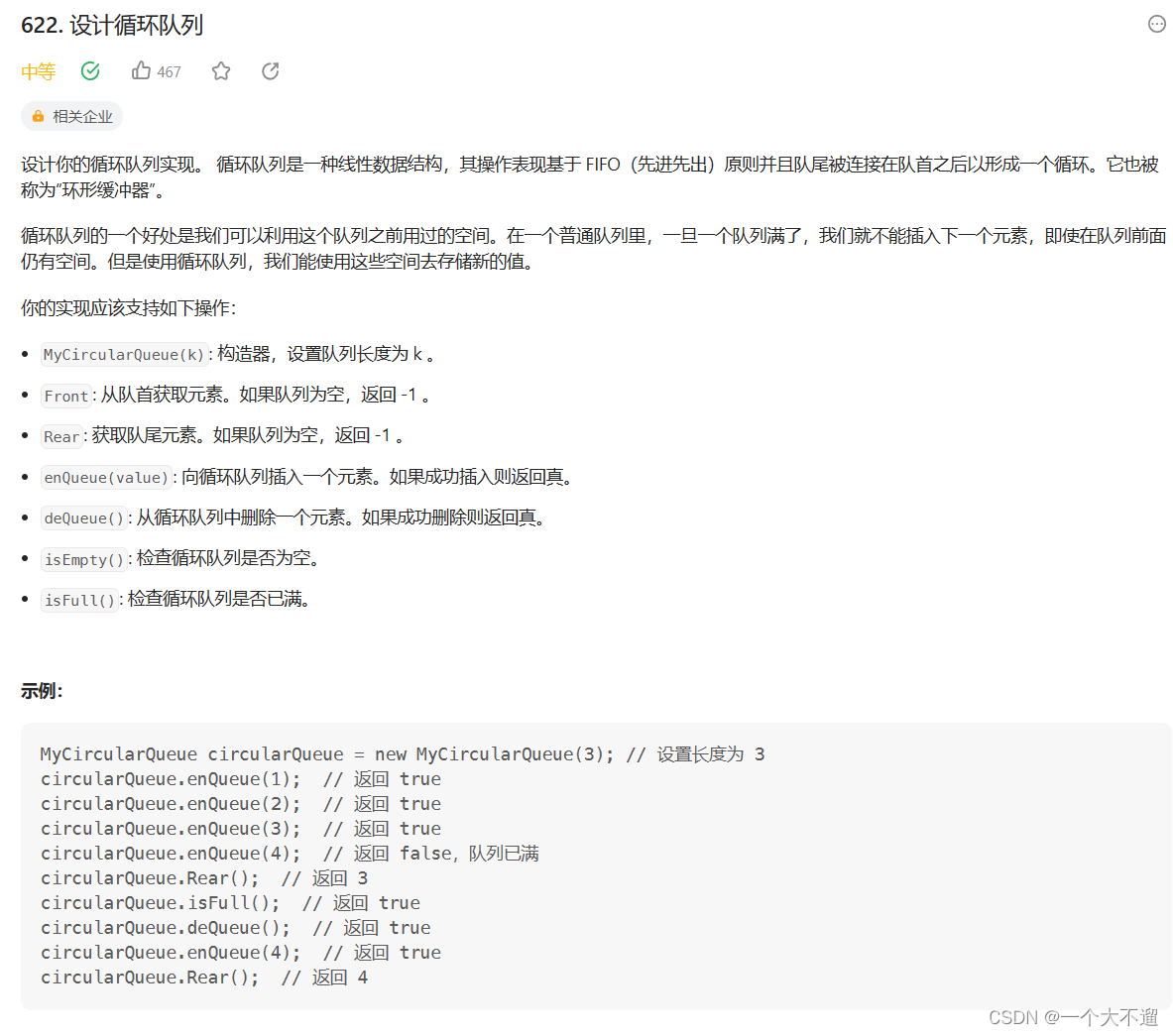
解决循环队列问题的话
我们可以先定义固定大小的数组,用来存储元素
例如,我们需要一个可以存储3个数据的数组,我们现在就开辟4个数据的空间,以便于我们操作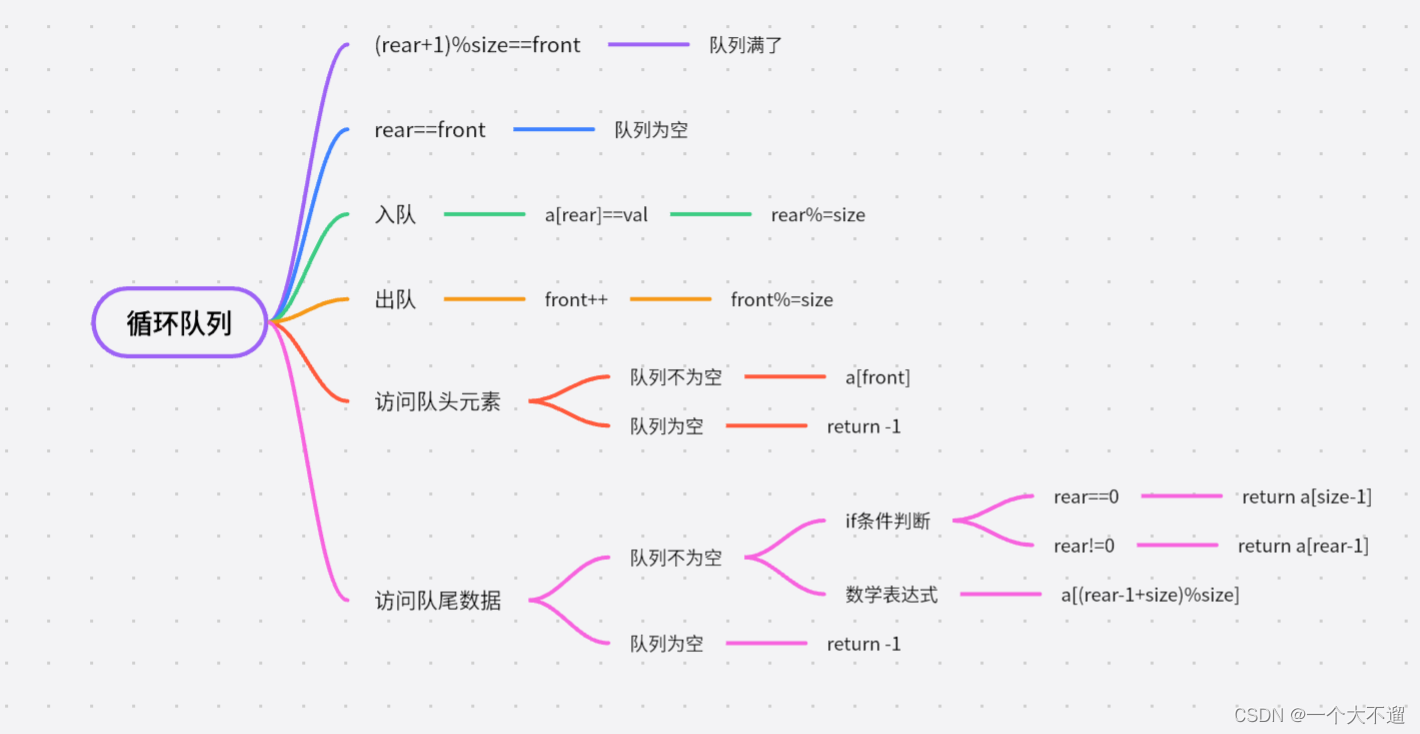
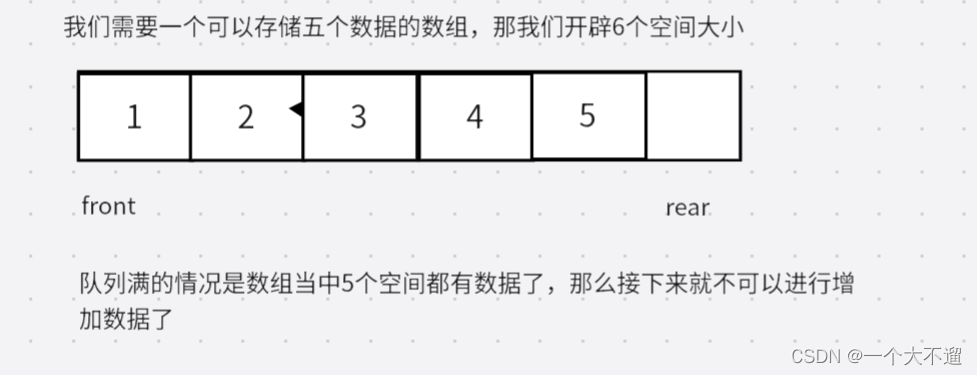
typedef struct {int front;int rear;int size;int *a;
} MyCircularQueue;
bool myCircularQueueIsFull(MyCircularQueue* obj) ;MyCircularQueue* myCircularQueueCreate(int k) {MyCircularQueue*obj=(MyCircularQueue*)malloc(sizeof(MyCircularQueue));obj->a=(int*)malloc(sizeof(int)*(k+1));obj->size=k+1;obj->front=0;obj->rear=0;return obj;
}bool myCircularQueueEnQueue(MyCircularQueue* obj, int value) {if((obj->rear+1)%(obj->size)==obj->front)return false;obj->a[obj->rear]=value;obj->rear++;obj->rear%=obj->size;return true;
}bool myCircularQueueDeQueue(MyCircularQueue* obj) {if(obj->rear==obj->front)return false;(obj->front)++;obj->front%=obj->size;return true;
}int myCircularQueueFront(MyCircularQueue* obj) {if(obj->rear==obj->front)return -1;return obj->a[obj->front];
}int myCircularQueueRear(MyCircularQueue* obj) {if(obj->rear==obj->front)return -1;return obj->a[(obj->rear-1+obj->size)%obj->size];}bool myCircularQueueIsEmpty(MyCircularQueue* obj) {if(obj->rear==obj->front)return true;return false;
}bool myCircularQueueIsFull(MyCircularQueue* obj) {if((obj->rear+1)%(obj->size)==obj->front)return true;return false;
}void myCircularQueueFree(MyCircularQueue* obj) {free(obj->a);obj->a=NULL;free(obj);
}/*** Your MyCircularQueue struct will be instantiated and called as such:* MyCircularQueue* obj = myCircularQueueCreate(k);* bool param_1 = myCircularQueueEnQueue(obj, value);* bool param_2 = myCircularQueueDeQueue(obj);* int param_3 = myCircularQueueFront(obj);* int param_4 = myCircularQueueRear(obj);* bool param_5 = myCircularQueueIsEmpty(obj);* bool param_6 = myCircularQueueIsFull(obj);* myCircularQueueFree(obj);
*/
6、感谢与交流✅
🌹🌹🌹如果大家通过本篇博客收获了,对队列有了新的了解的话
那么希望支持一下哦如果还有不明白的,疑惑的话,或者什么比较好的建议的话,可以发到评论区,
我们一起解决,共同进步 ❗️❗️❗️
最后谢谢大家❗️❗️❗️💯💯💯




